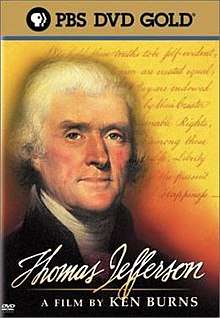Thomas Jefferson (film)
Thomas Jefferson is a 1997 two-part American documentary film directed and produced by Ken Burns. It covers the life and times of Thomas Jefferson, the 3rd President of the United States.
| Thomas Jefferson | |
|---|---|
 DVD cover | |
| Directed by | Ken Burns |
| Produced by | Ken Burns Camilla Rockwell |
| Written by | Geoffrey C. Ward |
| Narrated by | Ossie Davis |
| Cinematography | Ken Burns Peter B. Hutton Allen Moore Buddy Squires |
| Edited by | Paul Barnes Kevin Kertscher |
Production company | Florentine Films |
| Distributed by | Public Broadcasting Service |
Release date | 1997 (United States) |
Running time | 180 minutes |
| Country | United States |
| Language | English |
In the film Jefferson is portrayed as renaissance man. Not only was he a dedicated public servant, but was also a writer, an inventor, and a noted architect. Burns captures both the public and private person.
Actors and historians
Many noted actors read lines of various historical figures. A series of American university professors of history and political figures discussed background information.
Actors included:
- Ossie Davis – Narrator
- Sam Waterston – Thomas Jefferson
- Blythe Danner – Martha Jefferson
- Gwyneth Paltrow – Jefferson's granddaughter
- Philip Bosco as Sam Adams
Historians and political commentators included: Daniel Boorstin, Andrew Burstein, Joseph Ellis, Clay S. Jenkinson, Gore Vidal, George Will, Garry Wills, John Hope Franklin, James Oliver Horton and Julian Bond.
A topic of Jefferson's private life was the long-rumored liaison between Jefferson and his mixed-race slave Sally Hemings. She was a half-sister to his late wife, and the daughter of John Wayles and his slave Betty Hemings; Sally was three-quarters white. The white historians gave all the reasons they believed Jefferson would not have done it. Black historians discussed "reality and inevitability."[1] Noted historian John Hope Franklin referred to all the mulattos of the period and said, "These things [interracial liaisons] were part of the natural landscape in Virginia, and Mr. Jefferson was as likely as any others to have done this because it's in character with the times—and indeed, with him, who believed in exploiting these people that he controlled completely."[1]
Following airing of this film, in 1998 a Y-DNA study showed a match between a descendant of Sally's youngest son, Eston Hemings, and a descendant of the male Jefferson line. Following a review of other historic evidence, this has led to a consensus among historians, including the Thomas Jefferson Foundation of Monticello, that Jefferson did have a long-term relationship with Hemings and fathered her children.[2] Ellis and Burstein were among those who commented publicly about their change in thinking.[3][4][5]
References
- Edward J. Gallagher, "Episode 12: Overview" Archived November 29, 2014, at the Wayback Machine, The Jefferson-Hemings Controversy, Digital Library, Lehigh University
- "Thomas Jefferson and Sally Hemings: A Brief Account" Archived April 30, 2010, at the Wayback Machine, Monticello Website, accessed June 22, 2011, Quote: "Ten years later [referring to its 2000 report], TJF [Thomas Jefferson Foundation] and most historians now believe that, years after his wife's death, Thomas Jefferson was the father of the six children of Sally Hemings mentioned in Jefferson's records, including Beverly, Harriet, Madison and Eston Hemings."
- "Online Newshour: Thomas Jefferson". PBS. November 2, 1998. Archived from the original on May 2, 2006. Retrieved August 4, 2006.
- "Interview: Joseph Ellis" Archived December 25, 2016, at the Wayback Machine, Jefferson's Blood, 2000, PBS-Frontline, Quote: "We don't know for sure when Jefferson's relationship with Sally Hemings started. The DNA testing that has been done was done on the Eston Hemings line. Eston was born in 1805. It does seem that Jefferson had a long-term relationship with Sally Hemings."
- Richard Shenkman, "The Unknown Jefferson: An Interview with Andrew Burstein" Archived October 30, 2010, at the Wayback Machine, History News Network, July 25, 2005, accessed March 14, 2011.
External links
- Thomas Jefferson official website
- Review: Thomas Jefferson, The US Presidents (website)
- Ken Burns interview, C-SPAN (@ 1hr 2min)
- Joseph Ellis, "Whose Thomas Jefferson is he anyway?", New York Times, 16 February 1997
- Thomas Jefferson on IMDb